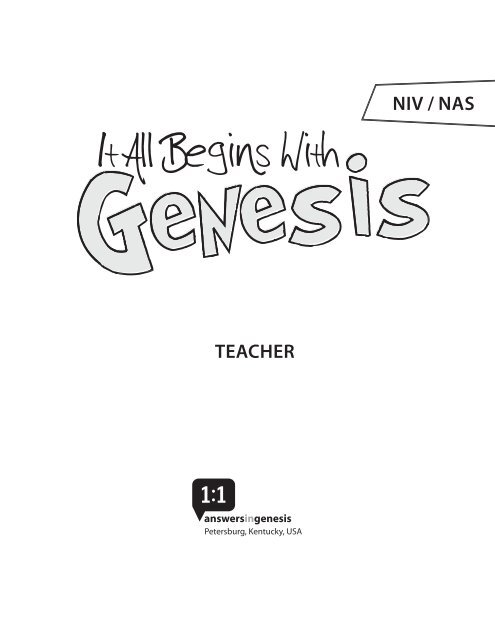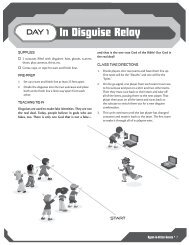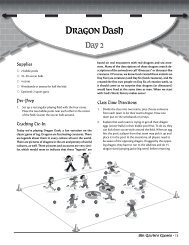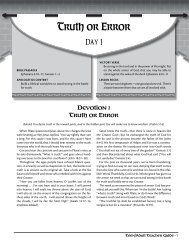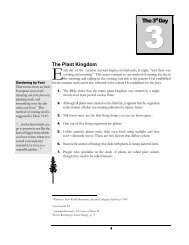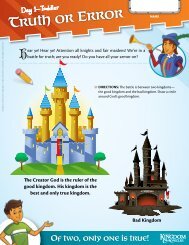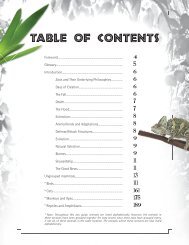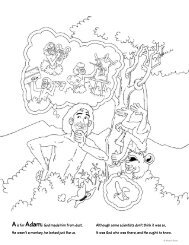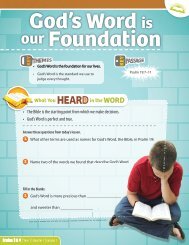It All Begins With - Answers in Genesis
It All Begins With - Answers in Genesis
It All Begins With - Answers in Genesis
Create successful ePaper yourself
Turn your PDF publications into a flip-book with our unique Google optimized e-Paper software.
NIV / NAS<br />
<strong>It</strong> <strong>All</strong> <strong>Beg<strong>in</strong>s</strong> <strong>With</strong><br />
<strong>Genesis</strong><br />
TEACHER<br />
Petersburg, Kentucky, USA
<strong>It</strong> <strong>All</strong> <strong>Beg<strong>in</strong>s</strong> <strong>With</strong> <strong>Genesis</strong><br />
Teacher Book NIV/NAS<br />
A Student Book should be purchased for each student, whether <strong>in</strong> the Christian school<br />
classroom or <strong>in</strong> the homeschool environment. In a classroom sett<strong>in</strong>g, always order one<br />
extra for the teacher so that you have copies of everyth<strong>in</strong>g for reference. Students will<br />
take home the pages of the Student Book throughout the study.<br />
First pr<strong>in</strong>t<strong>in</strong>g: Janurary 2010<br />
Copyright © 2001, 2010 Sheila Richardson. <strong>All</strong> rights reserved. No part of this publication<br />
may be reproduced <strong>in</strong> any form or by any means without prior written permission of the<br />
publisher. For more <strong>in</strong>formation write: <strong>Answers</strong> <strong>in</strong> <strong>Genesis</strong>, PO Box 510, Hebron KY 41048<br />
ISBN: 1-60092-296-1<br />
Author: Sheila Richardson<br />
Cover desg<strong>in</strong> and <strong>in</strong>terior layout: Diane K<strong>in</strong>g<br />
Scripture taken from the HOLY BIBLE, NEW INTERNATIONAL VERSION®. Copyright ©<br />
1973, 1978, 1984 International Bible Society. Used by permission of Zondervan. <strong>All</strong> rights<br />
reserved.<br />
The "NIV" and "New International Version" trademarks are registered <strong>in</strong> the United States<br />
Patent and Trademark Office by International Bible Society. Use of either trademark<br />
requires the permission of International Bible Society.<br />
Cover image © istockphoto.com/Aldo Murillo<br />
Clipart © 2009 Jupiterimages Corporation. Used under license.<br />
You may contact the author:<br />
Sheila Richardson<br />
3474 Dunrov<strong>in</strong> Farm<br />
Crozet, VA 22932<br />
434-823-4438<br />
dunrov<strong>in</strong>@es<strong>in</strong>et.net<br />
Pr<strong>in</strong>ted <strong>in</strong> Ch<strong>in</strong>a<br />
www.answers<strong>in</strong>genesis.org
Table of Contents<br />
Teacher Introduction . . . . . . . . . . . . . . . . . . . . . . . . . . . . . . . . . . . . . . . v<br />
Lesson 1 There is more than one way to look at your world . . . . . . . . . . . . . T-11<br />
Lesson 2 The foundation for your worldview is <strong>Genesis</strong>. . . . . . . . . . . . . . . . T-17<br />
Lesson 3 Inductive Bible study: We learn to observe . . . . . . . . . . . . . . . . . . T-21<br />
Lesson 4 Hik<strong>in</strong>g through <strong>Genesis</strong> 1 . . . . . . . . . . . . . . . . . . . . . . . . . . . . T-25<br />
Lesson 5 The Tr<strong>in</strong>ity <strong>in</strong> Creation . . . . . . . . . . . . . . . . . . . . . . . . . . . . . . T-29<br />
Lesson 6 The Days of Creation: A closer look at Days 1 –3 . . . . . . . . . . . . . . T-33<br />
Lesson 7 The Days of Creation: A closer look at Days 4–6 . . . . . . . . . . . . . . T-39<br />
Lesson 8 How old is God’s world? . . . . . . . . . . . . . . . . . . . . . . . . . . . . . T-49<br />
Lesson 9 God’s special creation: mank<strong>in</strong>d . . . . . . . . . . . . . . . . . . . . . . . . T-57<br />
Lesson 10 How special are you? . . . . . . . . . . . . . . . . . . . . . . . . . . . . . . T-59<br />
Lesson 11 Life before s<strong>in</strong> came <strong>in</strong>to the world. . . . . . . . . . . . . . . . . . . . . . T-63<br />
Lesson 12 Recogniz<strong>in</strong>g different worldviews <strong>in</strong> Scripture (part 1). . . . . . . . . . T-65<br />
Lesson 13 Recogniz<strong>in</strong>g different worldviews <strong>in</strong> Scripture (part 2) . . . . . . . . . T-69<br />
Lesson 14 Recogniz<strong>in</strong>g different worldviews <strong>in</strong> our culture. . . . . . . . . . . . . . T-71<br />
Lesson 15 Recogniz<strong>in</strong>g different worldviews <strong>in</strong> science (part 1) . . . . . . . . . . . T-75<br />
Lesson 16 Recogniz<strong>in</strong>g different worldviews <strong>in</strong> science (part 2) . . . . . . . . . . . T-83<br />
Lesson 17 Recogniz<strong>in</strong>g different worldviews <strong>in</strong> science (part 3) . . . . . . . . . . . T-95<br />
Lesson 18 Recogniz<strong>in</strong>g different worldviews <strong>in</strong> science (part 4) . . . . . . . . . . T-103<br />
Lesson 19 Recogniz<strong>in</strong>g different worldviews <strong>in</strong> science (part 5) . . . . . . . . . . T-125<br />
Lesson 20 How did evil come <strong>in</strong>to the world? . . . . . . . . . . . . . . . . . . . . . T-129<br />
Lesson 21 Temptation and s<strong>in</strong> . . . . . . . . . . . . . . . . . . . . . . . . . . . . . . T-131<br />
Lesson 22 Portrait of the serpent. . . . . . . . . . . . . . . . . . . . . . . . . . . . . T-135<br />
Lesson 23 The fallen world . . . . . . . . . . . . . . . . . . . . . . . . . . . . . . . . T-139<br />
Lesson 24 God’s solution. . . . . . . . . . . . . . . . . . . . . . . . . . . . . . . . . . T-143<br />
Lesson 25 Life <strong>in</strong> the fallen world: Ca<strong>in</strong> and Abel . . . . . . . . . . . . . . . . . . . T-149<br />
iii
Lesson 26 Life <strong>in</strong> the fallen world: Adam’s descendants . . . . . . . . . . . . . . . T-151<br />
Lesson 27 Events that led to God’s judgment . . . . . . . . . . . . . . . . . . . . . T-155<br />
Lesson 28 The Flood . . . . . . . . . . . . . . . . . . . . . . . . . . . . . . . . . . . . T-161<br />
Lesson 29 The voyage of the Ark . . . . . . . . . . . . . . . . . . . . . . . . . . . . . T-165<br />
Lesson 30 D<strong>in</strong>osaurs and the Flood . . . . . . . . . . . . . . . . . . . . . . . . . . . T-173<br />
Lesson 31 Is there evidence of a worldwide Flood?. . . . . . . . . . . . . . . . . . T-177<br />
Lesson 32 After the Flood . . . . . . . . . . . . . . . . . . . . . . . . . . . . . . . . . T-189<br />
Lesson 33 Different languages, peoples, nations? . . . . . . . . . . . . . . . . . . . T-199<br />
Lesson 34 God’s plan for His world unfolds . . . . . . . . . . . . . . . . . . . . . . T-207<br />
iv
<strong>It</strong> <strong>All</strong> <strong>Beg<strong>in</strong>s</strong> <strong>With</strong><br />
<strong>Genesis</strong><br />
Introduction<br />
This course consists of 34 lessons. <strong>It</strong> is designed<br />
to fit the average year-long Sunday school<br />
curriculum. If a shorter course is desired, the<br />
orig<strong>in</strong>s/worldview section (lessons 12–19) may<br />
be used as a stand-alone study of orig<strong>in</strong>s and<br />
science with<strong>in</strong> the biblical framework.<br />
The subject matter is best suited to middleschool<br />
young people, grades 6–8. Children <strong>in</strong><br />
grades 3–5 may also be capable of complet<strong>in</strong>g<br />
the lessons, but the concepts presented are<br />
better understood and applied by the older<br />
child. High-school students and even some<br />
adults could also benefit from the course.<br />
Some of the illustrations would need to be<br />
changed for the more mature student.<br />
The course can be adapted successfully to a<br />
day-school curriculum that can be used <strong>in</strong><br />
Christian schools or homeschool.<br />
This course <strong>in</strong>cludes<br />
• Student lessons that will be completed<br />
dur<strong>in</strong>g each class. There is more material <strong>in</strong><br />
each lesson than normally can be completed<br />
<strong>in</strong> a 45-m<strong>in</strong>ute class. This enables the<br />
teacher to pick and choose for enrichment<br />
as well as to assign home study, if desired.<br />
• Teacher guides that <strong>in</strong>clude the goals for<br />
each lesson, the materials needed for the<br />
lesson, a suggested teach<strong>in</strong>g plan and<br />
suggestions for activities and games that<br />
will accomplish the plan. The enclosed CD<br />
<strong>in</strong>cludes sample activities and masters that<br />
can be used with the lessons.<br />
Three ma<strong>in</strong> goals<br />
1.<br />
2.<br />
The first and major goal is that the student<br />
beg<strong>in</strong>s to build a solidly biblical worldview.<br />
Any worldview is most of all determ<strong>in</strong>ed<br />
by a person’s understand<strong>in</strong>g of God. <strong>It</strong> is<br />
our desire to <strong>in</strong>still <strong>in</strong> the learner a love for<br />
God’s Word and His world. <strong>It</strong> is also our<br />
goal to help the student discern the various<br />
worldviews that drive much of what he<br />
sees and hears <strong>in</strong> the secular culture.<br />
The second goal is closely connected to the<br />
first. S<strong>in</strong>ce the book of <strong>Genesis</strong> (chapters<br />
v
3.<br />
1–11) is the foundation for the Christian<br />
worldview, it will be the focus for our <strong>in</strong>depth<br />
study. The orig<strong>in</strong> of every doctr<strong>in</strong>e of<br />
Christianity— Creation, Fall, judgment and<br />
redemption—is found <strong>in</strong> <strong>Genesis</strong>.<br />
The f<strong>in</strong>al goal is that the student learns<br />
the pr<strong>in</strong>ciples of <strong>in</strong>ductive Bible study.<br />
The message of <strong>Genesis</strong> will be revealed<br />
as <strong>in</strong>ductive study is practiced. He will<br />
practice pr<strong>in</strong>ciples of Bible study that<br />
<strong>in</strong>corporate useful tools for observ<strong>in</strong>g,<br />
<strong>in</strong>terpret<strong>in</strong>g and apply<strong>in</strong>g the text. He will<br />
see for himself what the Word teaches.<br />
These tools, when developed, will serve<br />
him well throughout a lifetime of study<strong>in</strong>g<br />
God’s Word.<br />
Integrat<strong>in</strong>g the Seven C’s <strong>in</strong>to Your<br />
Curriculum<br />
Throughout <strong>It</strong> <strong>All</strong> <strong>Beg<strong>in</strong>s</strong> with <strong>Genesis</strong> you will<br />
see references to the Seven C’s of History.<br />
You will f<strong>in</strong>d a 7 C’s Connection <strong>in</strong> each<br />
lesson identify<strong>in</strong>g how the lesson topic<br />
l<strong>in</strong>es up with biblical history. Students will<br />
f<strong>in</strong>d this feature at the end of each lesson<br />
with blanks to fill <strong>in</strong> to demonstrate their<br />
understand<strong>in</strong>g of the connections.<br />
The Seven C’s can be used to develop a biblical<br />
worldview <strong>in</strong> students, young or old. Much<br />
more than enterta<strong>in</strong><strong>in</strong>g stories and religious<br />
teach<strong>in</strong>gs, the Bible has real connections to our<br />
everyday life. <strong>It</strong> may be hard, at first, to see how<br />
many connections there are, but with practice<br />
,the daily relevance of God’s Word will come<br />
alive. Let’s look at the Seven C’s of History<br />
and how each can be connected to what the<br />
students are learn<strong>in</strong>g.<br />
Creation<br />
God perfectly created the heavens,<br />
the earth, and all that is <strong>in</strong> them <strong>in</strong><br />
six normal-length days around 6,000 years ago.<br />
This teach<strong>in</strong>g is foundational to a biblical<br />
worldview and can be put <strong>in</strong>to the context of<br />
any subject. In science, the amaz<strong>in</strong>g design that<br />
we see <strong>in</strong> nature—whether <strong>in</strong> the ve<strong>in</strong>s of a<br />
leaf or the complexity of your hand—is all the<br />
handiwork of God. Virtually all of the lessons <strong>in</strong><br />
<strong>It</strong> <strong>All</strong> <strong>Beg<strong>in</strong>s</strong> with <strong>Genesis</strong> can be related to God’s<br />
creation of the heavens and earth.<br />
Other contexts <strong>in</strong>clude:<br />
Natural laws—any discussion of a law of nature<br />
naturally leads to God’s creative power.<br />
DNA and <strong>in</strong>formation—the <strong>in</strong>formation <strong>in</strong><br />
every liv<strong>in</strong>g th<strong>in</strong>g was created by God’s<br />
supreme <strong>in</strong>telligence.<br />
Mathematics—the laws of mathematics reflect<br />
the order of the Creator.<br />
Biological diversity—the dist<strong>in</strong>ct k<strong>in</strong>ds of<br />
animals that we see were created dur<strong>in</strong>g<br />
the Creation Week, not as products of<br />
evolution.<br />
Art—the creativity of man is demonstrated<br />
through various art forms.<br />
History—all time scales can be compared to<br />
the biblical time scale extend<strong>in</strong>g back<br />
about 6,000 years.<br />
Ecology—God has called mank<strong>in</strong>d to act as<br />
stewards over His creation.<br />
vi
Corruption<br />
After God completed His perfect<br />
creation, Adam disobeyed God by<br />
eat<strong>in</strong>g the forbidden fruit. As a result, s<strong>in</strong> and<br />
death entered the world, and the world has<br />
been <strong>in</strong> decay s<strong>in</strong>ce that time. This po<strong>in</strong>t is<br />
evident throughout the world that we live <strong>in</strong>.<br />
The struggle for survival <strong>in</strong> animals, the death<br />
of loved ones, and the violence all around us<br />
are all examples of the corrupt<strong>in</strong>g <strong>in</strong>fluence<br />
of s<strong>in</strong>.<br />
Other contexts <strong>in</strong>clude:<br />
Genetics—the mutations that lead to diseases,<br />
cancer, and variation with<strong>in</strong> populations<br />
are the result of corruption.<br />
Biological relationships—predators and<br />
parasites result from corruption.<br />
History—wars and struggles between mank<strong>in</strong>d,<br />
exemplified <strong>in</strong> the account of Ca<strong>in</strong> and<br />
Abel, are a result of s<strong>in</strong>.<br />
Catastrophe<br />
God was grieved by the<br />
wickedness of mank<strong>in</strong>d and<br />
judged this wickedness with a global Flood. The<br />
Flood covered the entire surface of the earth<br />
and killed all air-breath<strong>in</strong>g creatures that were<br />
not aboard the Ark. The eight people and the<br />
animals aboard the Ark replenished the earth<br />
after God delivered them from the catastrophe.<br />
The catastrophe described <strong>in</strong> the Bible would<br />
naturally leave beh<strong>in</strong>d much evidence. The<br />
studies of geology and of the biological<br />
diversity of animals on the planet are two of<br />
the most obvious applications of this event.<br />
Much of scientific understand<strong>in</strong>g is based<br />
on how a scientist views the events of the<br />
<strong>Genesis</strong> Flood.<br />
Other contexts <strong>in</strong>clude:<br />
Biological diversity—all of the birds, mammals,<br />
and other air-breath<strong>in</strong>g animals have<br />
populated the earth from the orig<strong>in</strong>al k<strong>in</strong>ds<br />
which left the Ark.<br />
Geology—the layers of sedimentary rock seen<br />
<strong>in</strong> roadcuts, canyons, and other geologic<br />
features are testaments to the global Flood.<br />
Geography—features like mounta<strong>in</strong>s, valleys,<br />
and pla<strong>in</strong>s were formed as the floodwaters<br />
receded.<br />
Physics—ra<strong>in</strong>bows are a perennial sign of God’s<br />
faithfulness and His pledge to never flood<br />
the entire earth aga<strong>in</strong>.<br />
Fossils—Most fossils are a result of the Flood<br />
rapidly bury<strong>in</strong>g plants and animals.<br />
Plate tectonics—the rapid movement of the<br />
earth’s plates likely accompanied the Flood.<br />
Global warm<strong>in</strong>g/Ice Age—both of these items<br />
are likely a result of the activity of the<br />
Flood. The warm<strong>in</strong>g we are experienc<strong>in</strong>g<br />
today has been present s<strong>in</strong>ce the peak of<br />
the Ice Age (with variations over time).<br />
vii
Confusion<br />
God commanded Noah and his<br />
descendants to spread across<br />
the earth. The refusal to obey this command<br />
and the build<strong>in</strong>g of the tower at Babel caused<br />
God to judge this s<strong>in</strong>. The common language<br />
of the people was confused and they spread<br />
across the globe as groups with a common<br />
language. <strong>All</strong> people are truly of “one blood” as<br />
descendants of Noah and, orig<strong>in</strong>ally, Adam.<br />
The confusion of the languages led people to<br />
scatter across the globe. As people settled <strong>in</strong><br />
new areas, the traits they carried with them<br />
became concentrated <strong>in</strong> those populations.<br />
Traits like dark sk<strong>in</strong> were beneficial <strong>in</strong> the<br />
tropics while other traits benefited populations<br />
<strong>in</strong> northern climates, and dist<strong>in</strong>ct people<br />
groups, not races, developed.<br />
Other contexts <strong>in</strong>clude:<br />
Genetics—the study of human DNA has shown<br />
that there is little difference <strong>in</strong> the genetic<br />
makeup of the so-called “races.”<br />
Languages—there are about seventy language<br />
groups from which all modern languages<br />
have developed.<br />
Archaeology—the presence of common<br />
build<strong>in</strong>g structures, like pyramids, around<br />
the world confirms the biblical account.<br />
Literature—recorded and oral records tell of<br />
similar events relat<strong>in</strong>g to the Flood and the<br />
dispersion at Babel.<br />
Christ<br />
God did not leave mank<strong>in</strong>d<br />
without a way to be redeemed<br />
from its s<strong>in</strong>ful state. The Law was given to<br />
Moses to show how far away man is from<br />
God’s standard of perfection. Rather than the<br />
sacrifices, which only covered s<strong>in</strong>s, people<br />
needed a Savior to take away their s<strong>in</strong>. This was<br />
accomplished when Jesus Christ came to earth<br />
to live a perfect life and, by that obedience, was<br />
able to be the sacrifice to satisfy God’s wrath<br />
for all who believe.<br />
The deity of Christ and the amaz<strong>in</strong>g plan that<br />
was set forth before the foundation of the<br />
earth is the core of Christian doctr<strong>in</strong>e. The<br />
earthly life of Jesus was the fulfillment of many<br />
prophecies and confirms the truthfulness of<br />
the Bible. His miracles and presence <strong>in</strong> human<br />
form demonstrate that God is both <strong>in</strong>timately<br />
concerned with His creation and able to<br />
control it <strong>in</strong> an absolute way.<br />
Other contexts <strong>in</strong>clude:<br />
Psychology—popular secular psychology<br />
teaches of the <strong>in</strong>herent goodness of man,<br />
but Christ has lived the only perfect life.<br />
Mank<strong>in</strong>d needs a Savior to redeem it from<br />
its unrighteousness.<br />
Biology—Christ’s virg<strong>in</strong> birth demonstrates<br />
God’s sovereignty over nature.<br />
Physics—turn<strong>in</strong>g the water <strong>in</strong>to w<strong>in</strong>e and the<br />
feed<strong>in</strong>g of the five thousand demonstrate<br />
Christ’s deity and His sovereignty over<br />
nature.<br />
History—time is marked (<strong>in</strong> the western world)<br />
based on the birth of Christ despite current<br />
efforts to change the mean<strong>in</strong>g.<br />
Art—much art is based on the life of Christ and<br />
many of the masters are known for these<br />
depictions, whether on canvas or <strong>in</strong> music.<br />
viii
Cross<br />
Because God is perfectly just<br />
and holy, He must punish s<strong>in</strong>.<br />
The s<strong>in</strong>less life of Jesus Christ was offered as a<br />
substitutionary sacrifice for all of those who<br />
will repent and put their faith <strong>in</strong> the Savior.<br />
After His death on the Cross, He defeated<br />
death by ris<strong>in</strong>g on the third day and is now<br />
seated at the right hand of God.<br />
The events surround<strong>in</strong>g the crucifixion and<br />
resurrection have a most significant place<br />
<strong>in</strong> the life of Christians. Though there is no<br />
way to scientifically prove the resurrection,<br />
there is likewise no way to prove the stories<br />
of evolutionary history. These are matters of<br />
faith founded <strong>in</strong> the truth of God’s Word and<br />
His character. The eyewitness testimony of<br />
over 500 people and the written Word of God<br />
provide the basis for our belief.<br />
Other contexts <strong>in</strong>clude:<br />
Biology—the biological details of the crucifixion<br />
can be studied alongside the anatomy of<br />
the human body.<br />
History—the use of crucifixion as a method of<br />
punishment was short-lived <strong>in</strong> historical<br />
terms and not known at the time it was<br />
prophesied.<br />
Art—the crucifixion and resurrection have<br />
<strong>in</strong>spired many wonderful works of art.<br />
Consummation<br />
God, <strong>in</strong> His great mercy, has<br />
promised that He will restore<br />
the earth to its orig<strong>in</strong>al state—a world<br />
without death, suffer<strong>in</strong>g, war, and disease. The<br />
corruption <strong>in</strong>troduced by Adam’s s<strong>in</strong> will be<br />
removed. Those who have repented and put<br />
their trust <strong>in</strong> the completed work of Christ on<br />
the Cross will experience life <strong>in</strong> this new heaven<br />
and earth. We will be able to enjoy and worship<br />
God forever <strong>in</strong> a perfect place.<br />
This future event is a little more difficult to<br />
connect with academic subjects. However, the<br />
hope of a life <strong>in</strong> God’s presence and <strong>in</strong> the absence<br />
of s<strong>in</strong> can be <strong>in</strong>serted <strong>in</strong> discussions of human<br />
conflict, disease, suffer<strong>in</strong>g, and s<strong>in</strong> <strong>in</strong> general.<br />
Other contexts <strong>in</strong>clude:<br />
History—<strong>in</strong> discussions of war or human<br />
conflict the com<strong>in</strong>g age offers hope.<br />
Biology—the violent struggle for life seen <strong>in</strong> the<br />
predator-prey relationships will no longer<br />
ta<strong>in</strong>t the earth.<br />
Medic<strong>in</strong>e—while we struggle to f<strong>in</strong>d cures<br />
for diseases and alleviate the suffer<strong>in</strong>g of<br />
those endur<strong>in</strong>g the effects of the Curse, we<br />
ultimately place our hope <strong>in</strong> the heal<strong>in</strong>g<br />
that will come <strong>in</strong> the eternal state.<br />
The preced<strong>in</strong>g examples are given to provide<br />
ideas for <strong>in</strong>tegrat<strong>in</strong>g the Seven C’s of History<br />
<strong>in</strong>to a broad range of curriculum activities. We<br />
would recommend that you give your students,<br />
and yourself, a better understand<strong>in</strong>g of the<br />
Seven C’s framework by present<strong>in</strong>g lessons<br />
on the Seven C’sfrom AiG’s <strong>Answers</strong> for Kids<br />
curriculum. This curriculum beg<strong>in</strong>s with seven<br />
lessons that will establish a solid understand<strong>in</strong>g<br />
of the true history, and future, of the universe.<br />
Full lesson plans, activities, and student<br />
resources are provided <strong>in</strong> the curriculum set.<br />
See www.<strong>Answers</strong>Bookstore.com to order.<br />
ix
We also offer bookmarks display<strong>in</strong>g the Seven<br />
C’s and a wall chart. These can be used as visual<br />
cues for the students to help them recall the<br />
<strong>in</strong>formation and <strong>in</strong>tegrate new learn<strong>in</strong>g <strong>in</strong>to its<br />
proper place <strong>in</strong> a biblical worldview.<br />
Even if you use other curricula, you can still<br />
<strong>in</strong>corporate the Seven C’s teach<strong>in</strong>g <strong>in</strong>to those.<br />
Us<strong>in</strong>g this approach will help students make<br />
firm connections between biblical events<br />
and every aspect of the world around them,<br />
and they will beg<strong>in</strong> to develop a truly biblical<br />
worldview and not just add pieces of the Bible<br />
to what they learn <strong>in</strong> “the real world.”<br />
Resources for the teacher<br />
• A teacher’s guide is <strong>in</strong>cluded for each<br />
lesson. This guide was written for a<br />
45-m<strong>in</strong>ute Sunday school program,<br />
taught once a week for a school year (34<br />
weeks). The student lessons are <strong>in</strong>tended<br />
for completion dur<strong>in</strong>g the class period,<br />
with no home assignments. However, the<br />
lesson usually has more content than can<br />
be completed thoroughly <strong>in</strong> one Sunday<br />
school period. Opportunities are therefore<br />
available to extend the lesson an extra week<br />
<strong>in</strong> some cases, as well as to give homework<br />
assignments if desired. The lessons can<br />
also be adapted for daily use <strong>in</strong> a Christian<br />
school or homeschool environment.<br />
• Appendix materials are <strong>in</strong>cluded for many<br />
lessons on a separate CD. These <strong>in</strong>clude<br />
masters that you can use <strong>in</strong> PowerPo<strong>in</strong>t,<br />
transparencies or pr<strong>in</strong>touts.<br />
• This course is built on the Precept Upon<br />
Precept courses for <strong>Genesis</strong> part 1 and 2,<br />
written by Kay Arthur, Sheila Richardson<br />
and Dr. Kurt Wise. <strong>It</strong> would be extremely<br />
helpful for you as a teacher to work<br />
through these courses prior to teach<strong>in</strong>g<br />
this class. Videos with lectures by Dr. Wise<br />
are available for each lesson and are useful<br />
supplementary materials.<br />
• Other supplementary materials are<br />
available at www.<strong>Answers</strong>In<strong>Genesis</strong>.org.<br />
x
<strong>It</strong> <strong>All</strong> <strong>Beg<strong>in</strong>s</strong> <strong>With</strong><br />
<strong>Genesis</strong><br />
leSSon<br />
1<br />
There is more than one way to look at your world<br />
Scripture: <strong>Genesis</strong> 1:1, 26, 31<br />
Psalm 148:5; Isaiah 40:26; 45:12; Colossians 1:16 (Creator)<br />
2 Timothy 3:16; Psalm 119:142; John 1:14; 14:6; 17:17 (authority of Scripture)<br />
Suggested memory verse (choose one): Colossians 1:16; 2 Timothy 3:16; John 17:17<br />
What this lesson is about:<br />
This lesson <strong>in</strong>troduces the term ‘worldview.’ <strong>It</strong> po<strong>in</strong>ts to Scripture as the eyewitness to the orig<strong>in</strong> of<br />
all th<strong>in</strong>gs, and it addresses Scripture’s claim to absolute truth.<br />
7 C’s Connection: Creation<br />
goals for the lesson: The student should<br />
• be able to defi ne ‘worldview.’<br />
• understand the importance of the eyewitness (Scripture).<br />
• see Scripture’s claim to truth.<br />
• see what the eyewitness of Scripture claims regard<strong>in</strong>g the creation of all th<strong>in</strong>gs.<br />
Preparation for lesson:<br />
• Work through student’s lesson 1.<br />
• Read through the ‘delicious cake mystery’ (page T-13). Provide cake and the players necessary<br />
to perform the skit.<br />
• Prepare word puzzle materials (page T-15). You will also need glue or tape.<br />
• Funny eyeglasses (one pair for biblical worldview and one for naturalistic worldview) are helpful<br />
<strong>in</strong> illustrations.<br />
Plan for lesson:<br />
• Beg<strong>in</strong> with the ‘delicious cake mystery’ illustration (page T-13). The students should see<br />
that there is usually more than one reasonable explanation of the data (facts), yet two<br />
different explanations can’t both be true. The eyewitness report can often settle the<br />
matter.<br />
• Apply this pr<strong>in</strong>ciple to the creation of the world. Help students see the two major explanations<br />
that people have for the data. Ask, ‘Are both reasonable?’ (yes) ‘Can both be true?’ (no) Ask,<br />
‘What is the eyewitness?’ (Scripture)<br />
T - 11
1<br />
There is more than one way to look at your world<br />
• Apply also to the creation of man. Let students see the two ways that the orig<strong>in</strong> of man is<br />
expla<strong>in</strong>ed—ask the same questions.<br />
• Use this discussion as a spr<strong>in</strong>gboard to <strong>in</strong>troduce the concept of ‘worldview.’ Give out word<br />
puzzle pieces (found on page T-15—reproduce as necessary) and ask students to arrange them<br />
to form a def<strong>in</strong>ition for worldview. (Correct def<strong>in</strong>ition: ‘A total way of look<strong>in</strong>g at the world’<br />
or ‘A way of look<strong>in</strong>g at the total world.’) When they have glued the def<strong>in</strong>ition <strong>in</strong>to their notebooks,<br />
discuss the other def<strong>in</strong>itions given <strong>in</strong> the lesson and discuss the big questions that a<br />
worldview answers. Tell students that your goal this year will be to develop a biblical worldview,<br />
with answers to all of these questions. You will also look at the other major way of look<strong>in</strong>g at<br />
the world: the naturalistic worldview. (If you have two different pairs of eyeglasses, you can use<br />
them to illustrate the two different views.) Students will see which view is the most compell<strong>in</strong>g<br />
and evaluate where truth lies.<br />
• Class work. Ask, ‘What about this eyewitness, the Bible? Can it be trusted? How can we know<br />
what is really true?’ Have the students work through the five cross-references given <strong>in</strong> their<br />
lesson. Discuss their answers. (You can do this all together by hav<strong>in</strong>g a student read the verse<br />
aloud and everyone discuss<strong>in</strong>g the answer.)<br />
• Class work. Now look at the next group of cross-references. They give the biblical worldview<br />
for how all th<strong>in</strong>gs came to be. Have the students go through the Scriptures and <strong>in</strong>struct them<br />
to highlight or underl<strong>in</strong>e what the eyewitness teaches about the orig<strong>in</strong> of all th<strong>in</strong>gs. (You can<br />
have them work on their own or you can work together.)<br />
• Conclude by discuss<strong>in</strong>g the f<strong>in</strong>al questions: Does it make a difference? How can it change what<br />
you th<strong>in</strong>k and how you live?<br />
If you have additional time . . .<br />
Suggestions for augment<strong>in</strong>g lessons (home school, day school)<br />
This lesson <strong>in</strong>troduces the concept of worldviews. These are abstract concepts and will require<br />
frequent re<strong>in</strong>forcement. <strong>It</strong> would be helpful to add one more session to this lesson. <strong>It</strong> would<br />
allow more time to study the cross-references. <strong>It</strong> would also allow expanded illustration concern<strong>in</strong>g<br />
what makes up a worldview.<br />
T - 12
There is more than one way to look at your world 1<br />
Activity: The Delicious Cake Mystery<br />
This activity addresses the question ‘How can we know what is true?’ Children experience this confusion<br />
when they are taught biblical pr<strong>in</strong>ciples <strong>in</strong> the home and then hear conflict<strong>in</strong>g ideas outside<br />
the home. They hear oppos<strong>in</strong>g sides to an issue, and both seem reasonable. <strong>It</strong> is never too early to<br />
beg<strong>in</strong> to teach children to question, to discern, to realize that someone who seems smart may not<br />
necessarily be speak<strong>in</strong>g truth. This realization will lead <strong>in</strong>to an understand<strong>in</strong>g of ‘worldviews,’ which<br />
is a difficult concept for both children and adults to work <strong>in</strong>to their th<strong>in</strong>k<strong>in</strong>g, but it is most valuable.<br />
Worldviews will be addressed at length as this course cont<strong>in</strong>ues. The key thought to communicate<br />
<strong>in</strong> this activity is that the Bible conta<strong>in</strong>s absolute truth, and it is the only eyewitness report about<br />
the Creation. <strong>It</strong> must be the foundation on which we build all scientific models and answer all questions<br />
to which it speaks.<br />
Materials needed:<br />
A cake. (the more decorated and entic<strong>in</strong>g, the better!)<br />
Three actors. (Prompt three students before the class, or enlist helpers. For the complete conversation,<br />
see ‘Procedure’ on the next page.)<br />
1. One will say the name of the person he th<strong>in</strong>ks made the cake. (<strong>It</strong> could be the mother, the<br />
teacher or someone else whom everyone knows.)<br />
2. The second will say, ‘No, she bought it at the bakery.’<br />
The problem: ‘Which is true?’<br />
3. The third will stay outside the room until the discussion of the clues (below) has f<strong>in</strong>ished, and<br />
will come <strong>in</strong> and reveal that he was the eyewitness, who cl<strong>in</strong>ches the solution to the mystery.<br />
(Because of time constra<strong>in</strong>ts, you can perform one part and enlist another teacher or helper to<br />
play the other two parts.)<br />
3x5 <strong>in</strong>dex cards. On each card, write a clue. (Or you can skip the cards and simply carry on a dialogue<br />
with the other teacher or helper.) You can make up your own clues, but some suggestions<br />
<strong>in</strong>clude the follow<strong>in</strong>g:<br />
[Name of the suspected cake maker] loves to cook, and she often bakes cakes.<br />
The bakery near you home had a special sale on cakes today.<br />
There was a mix<strong>in</strong>g bowl and spoons and a pan <strong>in</strong> the dishwasher this morn<strong>in</strong>g.<br />
This cake is more beautiful than the cakes she usually makes.<br />
She has recently taken a cake-decorat<strong>in</strong>g course.<br />
Ten dollars is miss<strong>in</strong>g from her wallet.<br />
The flour canister is empty and some flour has been spilled on the floor.<br />
Jerry saw her <strong>in</strong> town this afternoon, only two blocks from the bakery.<br />
You saw a cake <strong>in</strong> the bakery yesterday that looked like this cake.<br />
T - 13
1<br />
There is more than one way to look at your world<br />
Procedure: (Note: The italic type represents what the parent or teacher may want to say to the<br />
class by way of explanation. You may simply read this to the class or rephrase it <strong>in</strong> your own words<br />
and add other explanatory <strong>in</strong>formation.)<br />
1. (Present the cake to the group to admire.) Look what I just found! Isn’t it a beautiful cake?<br />
Who made this cake—does anyone know? One student (prompted earlier by you) will say<br />
the name of someone who may have made the cake. Another will say the cake was bought<br />
at the bakery.<br />
2. How do we know which is true? Are there any clues? (Pick up the stack of <strong>in</strong>dex cards with the clues<br />
on them.) Scientists would call this ‘data.’ What observations can we conclude about this situation<br />
from these clue cards?<br />
3. Go through the <strong>in</strong>dex cards with the clues on them. Ask the class to say which hypothesis each<br />
clue card favors. Keep score on the board.<br />
4. Well, we’ve gone through both sets of cards and made our observations. Both choices seem plausible.<br />
How can we know? Now your f<strong>in</strong>al ‘planted’ actor comes <strong>in</strong>to the room and announces to the person<br />
who allegedly made the cake, ‘<strong>It</strong> was great see<strong>in</strong>g you this afternoon when you came <strong>in</strong>to the bakery<br />
and bought that yummy-look<strong>in</strong>g cake. I came over for a piece of that cake.’<br />
5. Ask them, What is so important about this last development? They should see that an eyewitness<br />
report (if it is a credible eyewitness) is much more valuable than a bunch of clues that can<br />
be <strong>in</strong>terpreted <strong>in</strong> different ways.<br />
6. Ask them, What does this have to do with the creation of the world? (Give them a chance to<br />
answer.) When it comes to the creation of the world, we often hear more than one idea about<br />
how it happened. (You can let them tell you what they have heard—the two basic views are<br />
that God created the world or it happened by chance through evolution.) There is more than<br />
one story of how th<strong>in</strong>gs got here, and each has evidence you can see, and each can be pretty persuasive.<br />
But was there an eyewitness to Creation? (They should be able to tell you that only God<br />
would know, and He told us <strong>in</strong> the Bible.) The only eyewitness report is found <strong>in</strong> the Bible. That<br />
should be our f<strong>in</strong>al evaluation of what is true. The truth is found <strong>in</strong> God’s Word. <strong>It</strong> is the only truth<br />
that is fully reliable. <strong>It</strong> should settle the mystery of how the world and all that is <strong>in</strong> it came to be .<br />
You can then eat the cake for snack time!<br />
T - 14
There is more than one way to look at your world 1<br />
Worldview puzzle template*<br />
A WAY of look<strong>in</strong>g<br />
at the total world<br />
A WAY of look<strong>in</strong>g<br />
at the total world<br />
A WAY of look<strong>in</strong>g<br />
at the total world<br />
A WAY of look<strong>in</strong>g<br />
at the total world<br />
A WAY of look<strong>in</strong>g<br />
at the total world<br />
*This activity is used by permission of Summit M<strong>in</strong>istries, found <strong>in</strong> their curriculum Worldviews<br />
<strong>in</strong> Focus: Th<strong>in</strong>k<strong>in</strong>g like a Christian by David Noebel and Chuck Edwards, Summit M<strong>in</strong>istries, 1999.<br />
Summit Press, PO Box 207, Manitou Spr<strong>in</strong>gs, Colorado 80829.<br />
T - 15
<strong>It</strong> <strong>All</strong> <strong>Beg<strong>in</strong>s</strong> <strong>With</strong><br />
<strong>Genesis</strong><br />
leSSon<br />
2<br />
The foundation for your worldview is <strong>Genesis</strong><br />
Scripture: Psalm 11:3; selected passages from <strong>Genesis</strong> 3–11<br />
Suggested memory verse (choose one): Psalm 11:3; <strong>Genesis</strong> 1:1<br />
What this lesson is about:<br />
This lesson teaches that <strong>Genesis</strong> is the foundation for the biblical worldview. When a foundation<br />
is destroyed, the entire build<strong>in</strong>g tumbles. The lesson also <strong>in</strong>troduces the <strong>in</strong>ductive study<br />
pr<strong>in</strong>ciple of the overview, and leads the students <strong>in</strong> a simple overview of <strong>Genesis</strong> 1–11.<br />
7C’s Connection: Creation, Corruption, Catastrophe, Confusion<br />
goals for the lesson: The student should<br />
• be able to give a defi nition of ‘worldview.’<br />
• have a beg<strong>in</strong>n<strong>in</strong>g understand<strong>in</strong>g of foundations and why <strong>Genesis</strong> is foundational.<br />
• know the four ma<strong>in</strong> events of <strong>Genesis</strong> 1–11.<br />
Preparation for lesson:<br />
• Work through the student’s lesson 2.<br />
• Prepare a bullet<strong>in</strong> board with the <strong>in</strong>formation about worldviews presented <strong>in</strong> last week’s lesson.<br />
(You could <strong>in</strong>clude def<strong>in</strong>itions given <strong>in</strong> the lesson, worldview questions and pictures of many<br />
different people look<strong>in</strong>g at the world.)<br />
• ‘Props’ for lesson: build<strong>in</strong>g blocks and toy house, toy helicopter or photograph of flyover view<br />
and toy eyeglasses with different colors of ‘glass.’<br />
Plan for lesson:<br />
• Review last’s week concept of worldviews. Give out the toy eyeglasses and ask the students<br />
what color different objects appear to be. After they ‘see’ different colors, use this as a spr<strong>in</strong>gboard<br />
to talk about the worldview lesson from last week. Use the bullet<strong>in</strong> board to review the<br />
def<strong>in</strong>ition of worldview and the k<strong>in</strong>d of questions answered by the worldview.<br />
• Tell the students that they will be study<strong>in</strong>g <strong>Genesis</strong> this year, because <strong>Genesis</strong> is the foundation<br />
of the biblical worldview. You might illustrate the foundational nature of <strong>Genesis</strong> by us<strong>in</strong>g<br />
build<strong>in</strong>g blocks and a toy house. Have a house perched on a big foundation and then <strong>in</strong>vite a<br />
student to knock out the foundation from underneath.<br />
T - 17
2<br />
The foundation for your worldview is <strong>Genesis</strong><br />
• Ask students if they know why <strong>Genesis</strong> is called the foundation of Scripture. If they can’t tell you,<br />
wait until they have f<strong>in</strong>ished their class work and then discuss it with them. Discuss Psalm 11:3<br />
and ask them about the consequences of hav<strong>in</strong>g a foundation removed.<br />
• Tell your students that they will be learn<strong>in</strong>g <strong>in</strong>ductive Bible study while they study <strong>Genesis</strong>. They<br />
will learn all about what ‘<strong>in</strong>ductive’ actually means next week, but today they will beg<strong>in</strong> by<br />
do<strong>in</strong>g the first step of <strong>in</strong>ductive study.<br />
• Expla<strong>in</strong> what an overview is and why it is necessary when you study Scripture. An overview is<br />
like fly<strong>in</strong>g over someth<strong>in</strong>g <strong>in</strong> a helicopter—it gives you the ‘big picture’ and helps you to see<br />
how the different pieces all fit together. If you have an aerial photograph, you can show how the<br />
overview enables you to see what is there and how th<strong>in</strong>gs fit together. They need to see how<br />
they can’t see all of those th<strong>in</strong>gs from the ground perspective.<br />
• Class work. Show the students the chart that they need to complete (on page 9 of their workbooks),<br />
and tell them that they are to look for the four ma<strong>in</strong> events of the first 11 chapters of<br />
<strong>Genesis</strong>. Let them look up the Scriptures <strong>in</strong> their Bibles and fill <strong>in</strong> the chart. Then they can draw<br />
a picture to represent each event. The four major events they should identify: the Creation, the<br />
Flood, the Fall, the nations. (Depend<strong>in</strong>g upon your time and number of students <strong>in</strong>volved, you<br />
may wish to assign one verse for each student to look up and read as you prompt them. The<br />
group as a whole can identify the event be<strong>in</strong>g described.)<br />
• Discussion. Look at each major event described <strong>in</strong> <strong>Genesis</strong> and ask the students how these<br />
th<strong>in</strong>gs could be expla<strong>in</strong>ed if they didn’t have <strong>Genesis</strong>.<br />
Chapters 1–2 (Creation of all th<strong>in</strong>gs, establishment of marriage, man’s dom<strong>in</strong>ion over earth) If<br />
we had no <strong>Genesis</strong>, we would have to expla<strong>in</strong> creation with some k<strong>in</strong>d of evolutionary scenario,<br />
marriage would not necessarily be between a man and a woman (homosexuality, no covenantal<br />
marriage, etc.), and man would be on same level as animals (‘animal rights’).<br />
Chapters 3–5 (The Fall of mank<strong>in</strong>d, results of the Fall—<strong>in</strong>clud<strong>in</strong>g murder and death) If we had<br />
no <strong>Genesis</strong>, we would have no way to expla<strong>in</strong> death, pa<strong>in</strong>, sorrow, evil, thorns and thistles <strong>in</strong> the<br />
world.<br />
Chapters 6–9 (The Flood) If we had no <strong>Genesis</strong>, then billions of fossils deposited <strong>in</strong> the Flood<br />
would have to be expla<strong>in</strong>ed naturalistically, we would not understand God as a Judge, and we<br />
would underestimate the power of God.<br />
Chapters 10–11 (Babel, descendants of the sons of Noah, orig<strong>in</strong> of languages and nations) If we<br />
had no <strong>Genesis</strong>, we would not know the orig<strong>in</strong> of people groups and languages; some people<br />
would consider racism justifiable.<br />
T - 18
The foundation for your worldview is <strong>Genesis</strong> 2<br />
If you have additional time . . .<br />
Suggestions for augment<strong>in</strong>g lessons (home school, day school)<br />
Suggested addition: five more sessions<br />
<strong>It</strong> would be helpful to do a complete overview of <strong>Genesis</strong> 1–11, if you have the time. Us<strong>in</strong>g<br />
the student observation sheets, <strong>in</strong>struct students to read each chapter and pick out the who<br />
(people <strong>in</strong> the chapter), what (events <strong>in</strong> the chapter) and where (geographical allusions) of<br />
each chapter. Then summarize the theme of each chapter and draw a picture of the ma<strong>in</strong> event<br />
<strong>in</strong> the chapter.<br />
You could break it down:<br />
Session 1: chapters 1–2<br />
Session 2: chapters 3–5<br />
Session 3: chapters 6–8<br />
Session 4: chapters 9–11<br />
Session 5: summary and review<br />
Ask the students what would be miss<strong>in</strong>g from our understand<strong>in</strong>g of our faith if we didn’t have<br />
<strong>Genesis</strong>. Ask them what worldview questions will be answered by study<strong>in</strong>g <strong>Genesis</strong>. Create a<br />
time-l<strong>in</strong>e bullet<strong>in</strong> board.<br />
Older students would probably benefit from watch<strong>in</strong>g Dr. Kurt Wise’s video lesson 1 from the<br />
adult Precept course <strong>Genesis</strong> 1.<br />
Other valuable resources <strong>in</strong>clude Ken Ham’s talk ‘Is <strong>Genesis</strong> relevant today?’ (a 30-m<strong>in</strong>ute video<br />
<strong>in</strong> the sem<strong>in</strong>ar series <strong>Answers</strong> ... with Ken Ham) and Demolish<strong>in</strong>g Strongholds sessions 1 and 2,<br />
available on DVD from www.<strong>Answers</strong>In<strong>Genesis</strong>.org.<br />
T - 19


